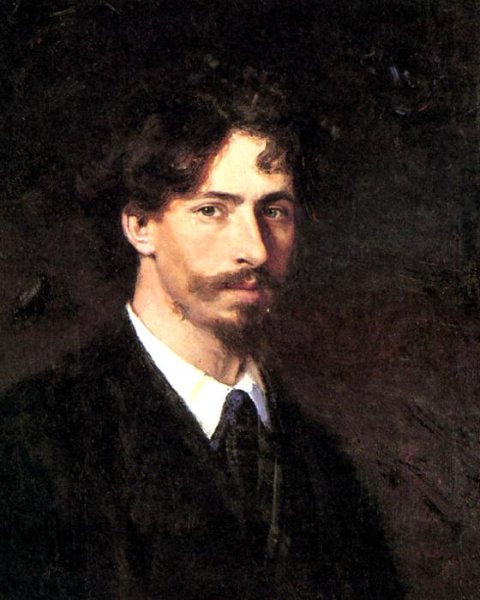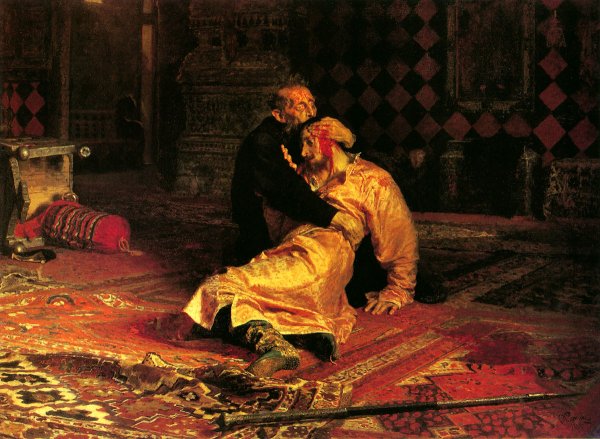Ilya Efimovich Repin Biography In Details
Life and work

Ilya Efimovich Repin was born in the town of Chuguev near Kharkov in the heart of the historical region called Sloboda Ukraine. His parents were Russian military settlers. In 1866, after apprenticeship with a local icon painter named Bunakov and preliminary study of portrait painting, he went to Saint Petersburg and was shortly admitted to the Imperial Academy of Arts as a student. From 1873 to 1876 on the Academy's allowance, Repin sojourned in Italy and lived in Paris, where he was exposed to French Impressionist painting, which had a lasting effect upon his use of light and colour. Nevertheless, his style was to remain closer to that of the old European masters, especially Rembrandt, and he never became an impressionist himself. Throughout his career, he was drawn to the common people from whom he himself traced his origins, and he frequently painted country folk, both Ukrainian and Russian, though in later years he also painted members of the Imperial Russian elite, the intelligentsia, and the aristocracy, including Tsar Nicholas II.
The itinerants
In 1878, Repin joined the free-thinking "Association of Peredvizhniki Artists", generally called "the Wanderers" or "The Itinerants" in English, who, at about the time of Repin's arrival in the capital, rebelled against the academic formalism of the official Academy. His fame was established by his painting of the "Volga Barge Haulers", a work which portrayed the hard lot of these poor folk but which was not without hope for the youth of Russia. From 1882 he lived in Saint Petersburg but did visit his Ukrainian homeland and on occasion made tours abroad.
Historical and contemporary subjects

Beginning shortly before the assassination of Tsar Alexander II in 1881, he painted a series of pictures dealing with the theme of the Russian revolutionary movement: "Refusal to Confess", "Arrest of a Propagandist", "The Meeting", and "They did not Expect Him", the last of which is undoubtedly his masterpiece on the subject, mixing contrasting psychological moods and Russian and Ukrainian national motifs. His large-scale "Religious Procession in the Province of Kursk" is sometimes considered an archetype of the "Russian national style" displaying various social classes and the tensions among them set within the context of a traditional religious practice and united by a slow but relentless forward movement.
In 1885, Repin completed one of his most psychologically intense paintings, Ivan the Terrible and his Son. This canvas displayed a horrified Ivan embracing his dying son, whom he had just struck and mortally wounded in an uncontrolled fit of rage. The visage of terrified Ivan is in marked contrast with that of his calm, almost Christlike son.
One of Repin's most complex paintings, Reply of the Zaporozhian Cossacks to Sultan Mehmed IV of the Ottoman Empire occupied many years of his life. He conceived this painting as a study in laughter, but also believed that it involved the ideals of liberty, equality, and fraternity; in short, Cossack republicanism. Begun in the late 1870s, it was only completed in 1891, and, ironically, was immediately purchased by the Tsar. The Tsar paid 35,000 rubles for the painting, an enormous amount for that time.
During his maturity, Repin painted many of his most celebrated compatriots, including the novelist Leo Tolstoy, the scientist Dmitri Mendeleev, the imperial official Pobedonostsev, the composer Mussorgsky, the philanthropist Pavel Tretyakov, and the Ukrainian poet and painter, Taras Shevchenko.
In 1903, he was commissioned by the Russian government to paint his most grandiose design, a 400x877 cm canvas representing a ceremonial session of the State Council of Imperial Russia.
Later life

Repin himself designed his home Penaty (literally, "the Penates") or the Roman "Household Gods", located just to the north of Saint Petersburg in Kuokkala, Grand Duchy of Finland. After the 1917 October Revolution, Finland declared independence. He was invited by various Soviet institutions to come back to his homeland but refused the invitation giving the excuse that he was too old to make the journey. During this period, Repin devoted much time to painting religious subjects, though his treatment of these was usually innovative and not traditional. With the exception of a portrait of Provisional Government head, Alexander Kerensky, he never painted anything substantial on the subject of the 1917 revolutions or the Soviet experiment that followed. His last painting, a joyous and exuberant canvas called "The Hopak", was on a Ukrainian Cossack theme. In 1930, he died in Kuokkala, Finland. After the Continuation War Kuokkala was ceded to the Soviet Union and was renamed Repino (Leningrad Oblast). The Penates are part of the World Heritage Site Saint Petersburg and Related Groups of Monuments. In 1940, Penaty was opened for the public as a house museum. Alexander Glazunov's Oriental Rhapsody, Op. 29 (1889) is dedicated to Ilya Repin. (From Wikipedia)




